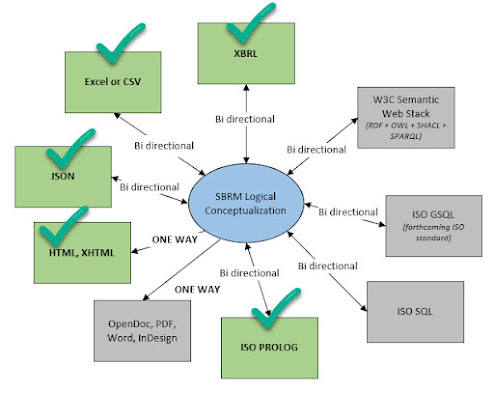Grounded in a Fixed System of Logical Patterns
As I see it, the forthcoming Standard Business Report Model (SBRM) that is being created by OMG and my Seattle Method logical conceptualizations are both grounded in a fixed system of logical patterns. The frameworks are fixed. There are a "fixed" or "finite" number of logical patterns of objects that fit together in specific ways within the framework. But you can put any number of objects described by that fixed set of logic into that framework.
That logic can be transformed between any physical technical format that can support the logic contained in that logical conceptualization. I have already effectively exchanged the logic of the LOREM IPSUM representation of the PROOF of all the logical patterns (this documented use case; this conformance suite test case) between Excel, XBRL, JSON bidirectionally; and HTML, PDF, and PROLOG one way.
What I mean by "fixed system of logical patterns" is the following. The Seattle Method and SBRM each provide a FRAMEWORK. That FRAMEWORK is fixed. You can put anything you want INTO that framework; you just need to follow tie FINITE LOGIC of the framework.
So for example; I have represented all of these financial reporting schemes (prototypes) using that one framework: Accounting Equation, SFAC 6, SFAC 8, Common Elements, MINI, PROOF, AASB 1060.
The logical patterns in the logical conceptualization are "inflexible". They are ridged, reliable, and comprehensive enough to represent the business use cases deemed necessary. The Seattle Method/SBRM are EXACTLY as flexible as they need to be: no more, no less. That makes them completely predictable.
Using that logic, you can represent whatever you want as demonstrated by the financial reporting scheme prototypes that I have provided. This Showcase of Reports shows the permutations and combinations that can be created using this tool.
If someone, a stakeholder of the system, believes that they can describe an additional business use case; that is all they need to do...describe the use case in detail, convince others that it is in fact a use case, and that additional logic can be added to the FRAMEWORK, keeping it (a) FIXED/FINITE and (b) bigger per that additional logic.
Why is this important? This fixed framework is important because it allows for a SAFE, RELIABLE, REPEATABLE, and therefore PREDICTABLE system. Logical paradoxes that can cause problems are avoided. The system is also based on a global standard technical format, XBRL. (Here is the history of XBRL.) SBRM clarifies the logical conceptualization of a business report. Every valid XBRL-based report submitted to the SEC or ESMA will be a valid XBRL + SBRM report.
This allows for precise flexibility and control. XBRL's extensibility is exacting and the modification of report models can be kept within permitted boundaries. As some people say, "guardrails" or "bumpers" are provided.
Computers are machines, finite state machines to be precise. They need some sort of fixed, finite set of logic work effectively. The objective is for that logical system the computer is processing to be safe, reliable, predictable so that work can be performed over and over (repeatable) and you get the same result each time.
These logical systems can get quite complex, but most of the complexity can be hidden from the user of the computer. Think about when you drive a car. When you drive a car you concern yourself with certain specific inputs and outputs: two pedals, a gearshift, steering wheel, speedometer, and such. You can safely operate the car without being an automotive engineer or mechanic.
But automotive engineers need to concern themselves with many more details and make sure everything works as would be expected and the right capabilities are provided to the driver of the car.
Indefinite logical thrown haphazardly to a computer would give you an unsatisfying result. That is why it is important to understand that you need that fixed system of logical patterns to create the predictability that causes the safe, reliable, repeatable work.
Additional information:




Comments
Post a Comment